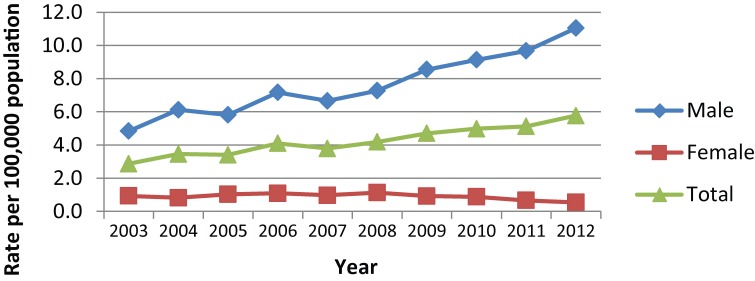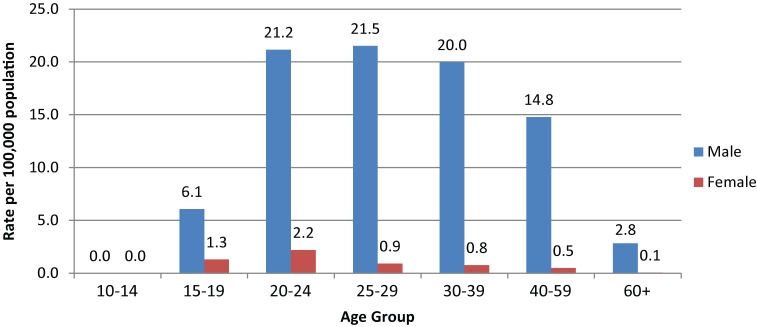Abstract
Background
In the 1990s, rates of reported cases of infectious syphilis were relatively low and were similar among males and females. In 2001, rates began to increase, particularly among males.
Objective
To identify trends in reported cases of infectious syphilis in Canada from January 1, 2003 to December 31, 2012.
Methods
Notifiable disease reports were submitted to the Public Health Agency of Canada by provincial and territorial epidemiological units and data were summarized by age and sex.
Results
Rates of reported cases of infectious syphilis increased by 101.0% between 2003 and 2012, from 2.9 to 5.8 per 100,000. Over this time frame, rates increased among males by 128.3% and decreased among females by 40.9%. In males, rates of infectious syphilis were highest among those aged 25 to 29; in females, rates were highest among those aged 20 to 24.
Conclusion
In Canada, as in many countries, rates of reported infectious syphilis cases in males have markedly increased over the last 10 years.
Introduction
Syphilis has been nationally notifiable since 1924. It is caused by the bacterium Treponema pallidum and if left untreated, will progress through primary, secondary, latent and tertiary stages. Tertiary syphilis damages the central nervous system, cardiovascular system, eyes, skin and other internal organs (1). Individuals with early (symptomatic) syphilis infections are also at increased risk of contracting HIV and those co-infected with both pathogens are more likely to transmit HIV to their sexual partners (2). In co-infected individuals, there is a greater chance of rapid progression to serious consequential conditions, such as neurosyphilis, often while those individuals are still infectious (3-5). While all stages of syphilis are nationally notifiable, only primary, secondary and early latent syphilis (less than one year after the point of infection) are considered infectious and therefore are of major public health significance. As a result, only these stages are included in national reports.
From 1993 to 2001, rates of reported cases of infectious syphilis were very similar between males and females, with both sexes experiencing low rates (less than 1.0 per 100,000) over this time frame. In 2001, infectious syphilis rates began to climb sharply, particularly among males (6).
The objective of this report is to summarize the trends in infectious syphilis rates in Canada between 2003 and 2012. It is based on the Report on Sexually Transmitted Infections in Canada: 2012 prepared by the Centre for Communicable Diseases and Infection Control of the Public Health Agency of Canada (PHAC) (available online) (7).
Methods
Data collection
Data on laboratory-confirmed gonorrhea cases were reported to the Canadian Notifiable Disease Surveillance System (CNDSS) by provincial and territorial health authorities according to the Agency’s Case Definitions for Communicable Diseases under National Surveillance (8) (see box below). Data are submitted in a variety of formats (e.g., line-listed electronic, paper-based case reports, or aggregate data) and are verified and loaded into the CNDSS database by Agency personnel.
Case definitions of infectious syphilis1
Primary Syphilis - Laboratory confirmation of infection:
Identification of T. pallidum by dark-field microscopy, fluorescent antibody, nucleic acid testing or equivalent examination of material from a chancre or a regional lymph node,
OR
Presence of one or more typical lesions (chancres) and reactive treponemal serology, regardless of non- treponemal test reactivity, in individuals with no previous history of syphilis,
OR
Presence of one or more typical lesions (chancres) and a fourfold or greater increase in the titre over the last known non-treponemal test in individuals with a past history of syphilis treatment.
Secondary Syphilis - Laboratory evidence of infection:
Identification of T. pallidum by dark-field microscopy, fluorescent antibody, nucleic acid testing or equivalent examination of mucocutaneous lesions, condylomata lata and reactive serology (non-treponemal and treponemal),
OR
Presence of typical signs or symptoms of secondary syphilis (e.g., mucocutaneous lesions, alopecia, loss of eyelashes and lateral third of eyebrows, iritis, generalized lymphadenopathy, fever, malaise or splenomegaly)
AND
Either a reactive serology (non-treponemal and treponemal OR a fourfold or greater increase in titre over the previous known non-treponemal test.
Early Latent Syphilis (< 1 year after infection) - Laboratory confirmation of infection:
An asymptomatic patient with reactive serology (treponemal and/or non-treponemal) who, within the previous 12 months, had one of the following: non-reactive serolog, symptoms suggestive of primary or secondary syphilis, exposure to a sexual partner with primary, secondary or early latent syphilis.
1 For the purpose of this summary, congenital syphilis and (non-infectious) late latent syphilis were not included.
Data analysis
Infectious syphilis data extracted from the CNDSS were analyzed by Centre for Communicable Diseases and Infection Control (CCDIC) staff. Rates were calculated by age group and sex using population estimates obtained from the Statistics Canada Demography Division. Rate change calculations were made on unrounded figures for greater precision.
Surveillance is considered to be within the mandate of federal/provincial/territorial (F/P/T) programs and does not constitute human research; therefore, no research ethics board approval was sought.
Results
In 2012, 2003 cases of infectious syphilis were reported, corresponding to a rate of 5.8 per 100,000 and a 101.0% increase from the 2003 rate of 2.9 per 100,000. The majority of cases (94.9%) reported in 2012 were among men. Between 2003 and 2012, rates among males increased by 128.3% from 4.8 to 11.0 per 100,000; conversely, rates among females decreased by 40.9% from 0.9 to 0.5 per 100,000 (Figure 1).
Figure 1.
Overall and sex-specific rates of reported infectious syphilis, 2003 to 2012, Canada
As in previous years, in 2012, the majority (65.6%) of all reported cases of infectious syphilis were among men aged 30 years and older. The highest rates were among men aged 25 to 29 years, followed by men aged 20 to 24 years (21.5 and 21.2 per 100,000, respectively) (Figure 2). Among women, rates of reported cases of infectious syphilis were substantially lower; the highest rates among women were observed among those aged 20 to 24 years, followed by those aged 15 to 19 years (2.2 and 1.3 per 100,000, respectively).
Figure 2.
Rates of reported infectious syphilis by sex and age group, 2012, Canada
Between 2003 and 2012, relative rate increases were observed in males of all age groups, with the exception of those in the 10 to 14 age group (where zero cases were reported). Over the same period, rates decreased among females of all ages, with the exception of those aged 10 to 14 (where zero cases were reported) and those in the 15 to 19 age group where rates increased from 1.2 to 1.3 per 100,000 (data not shown).
Between 2003 and 2012, outbreaks of infectious syphilis were reported across most jurisdictions in Canada.
Discussion
After a near-zero incidence of infectious syphilis, the number of reported cases began to rise in 2001 and continues to do so, especially among males. There is a significant difference in rates between males and females. Rates have more than doubled in males in the last 10 years, whereas they have decreased by a little over 40% in females. This resurgence appears to be primarily due to transmission among men who have sex with men (MSM). Increasing sexually transmitted infection (STI) rates among MSM have also been observed in the United States and Europe. The causes for these increases are complex and include demographic shifts as well as changing sexual attitudes and social contexts related to risky sexual practices (9).
There are several factors that must be taken into account when considering these data. For example, the number of cases of infectious syphilis in Canada is low relative to other STIs. As a result, population rates are variable and unstable and therefore changes over time should be interpreted with caution. That being said, the number of reported cases likely underestimates the true burden of infection; many people who are infected with syphilis do not have symptoms and therefore may not be tested by a health care practitioner.
Internationally, overall rates of infectious syphilis were lowest in the United States (5.0 per 100,000) (10), although this estimate does not include early latent cases. Among countries that included early latent syphilis cases, Australia had the highest rate (6.7 per 100,000) (11) and in England, the rate was 5.6 per 100,000 (12) compared to Canada’s rate of 5.8 per 100,000. Variations in annual rates of infectious syphilis across countries should be interpreted with caution as a result of differing reporting practices.
In conclusion, over a 10-year period, Canada has witnessed a 40% decrease in syphilis rates in women and a 128% increase in syphilis rates in men, which is consistent with trends seen in other Western countries.
Acknowledgements
The full report was prepared by the Centre for Communicable Diseases and Infection Control, Infectious Disease Prevention and Control Branch, Public Health Agency of Canada. Its publication would not have been possible without the collaboration of all provinces and territories, whose continuous contribution to national STI surveillance is greatly appreciated. The authors also acknowledge the contributions and expertise of the Sexually Transmitted and Blood-Borne Infections Surveillance Network.
Footnotes
Conflict of interest: None
Funding: This work was supported by the Public Health Agency of Canada.
References
- 1.Expert Working Group for the Canadian Guidelines on Sexually Transmitted Infections. Syphilis. In: Wong T, Latham-Carmanico C, editors. Canadian guidelines on sexually transmitted infections. 2010 ed. Ottawa: Public Health Agency of Canada; 2010. [Google Scholar]
- 2.Fleming DT, Wasserheit JN. From epidemiological synergy to public health policy and practice: the contribution of other sexually transmitted diseases to sexual transmission of HIV infection. Sex Transm Infect 1999. Feb;75(1):3–17. 10.1136/sti.75.1.3 [DOI] [PMC free article] [PubMed] [Google Scholar]
- 3.Buchacz K, Patel P, Taylor M, Kerndt PR, Byers RH, Holmberg SD et al. Syphilis increases HIV viral load and decreases CD4 cell counts in HIV-infected patients with new syphilis infections. AIDS 2004. Oct;18(15):2075–9. 10.1097/00002030-200410210-00012 [DOI] [PMC free article] [PubMed] [Google Scholar]
- 4.Pialoux G, Vimont S, Moulignier A, Buteux M, Abraham B, Bonnard P. Effect of HIV infection on the course of syphilis. AIDS Rev 2008. Apr-Jun;10(2):85–92. [PubMed] [Google Scholar]
- 5.Narula T, Kamboj S, Martinez J, Engel LS. Co-infection: HIV and the great mimic syphilis. HIV Clin 2010;22(2):7–10. [PubMed] [Google Scholar]
- 6.Public Health Agency of Canada. Report on sexually transmitted infections in Canada: 2011. Centre for Communicable Diseases and Infection Control, Infectious Disease Prevention and Control Branch, Public Health Agency of Canada; 2015. [Google Scholar]
- 7.Public Health Agency of Canada. Report on sexually transmitted infections in Canada: 2012. Centre for Communicable Diseases and Infection Control, Infectious Disease Prevention and Control Branch, Public Health Agency of Canada; 2015. [Google Scholar]
- 8.Public Health Agency of Canada. Case definitions for communicable diseases under national surveillance. Can Commun Dis Rep 2009;35:S-2. [PubMed] [Google Scholar]
- 9.Fenton KA, Imrie J. Increasing rates of sexually transmitted diseases in homosexual men in Western europe and the United States: why? Infect Dis Clin North Am 2005. Jun;19(2):311–31. 10.1016/j.idc.2005.04.004 [DOI] [PubMed] [Google Scholar]
- 10.Centers for Disease Control and Prevention. Sexually transmitted disease surveillance 2012. Atlanta: U.S. Department of Health and Human Services; 2013. http://www.cdc.gov/std/stats12/
- 11.The Kirby Institute. HIV, viral hepatitis and sexually transmissible infections. In Australia annual surveillance report 2013. The Kirby Institute, The University of New South Wales, Sydney NSW 2052. https://kirby.unsw.edu.au/surveillance/2013-annual-surveillance-report-hiv-viral-hepatitis-stis
- 12.Public Health England. Table 1: Number & rates of new STI diagnoses in England, 2003 – 2012. https://www.gov.uk/government/statistics




